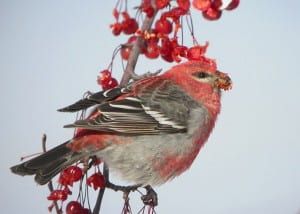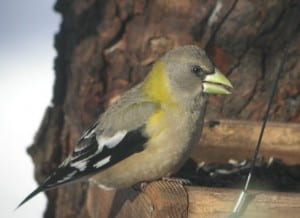Wisconsin birders are looking forward to an excellent finch winter!
Birds that usually winter in Canada are moving south. These atypical “irruptive migrations” are usually caused by changes in winter food availability and can occur in several northern species especially finches, owls and evening grosbeaks. This year finch species that normally winter in Canada and the northern United States are ranging farther south due to a massive crop failure of fruit and cone bearing trees in Canada. Birding expert and Ontario resident Ron Pittaway compiles local seed crop and late summer bird observations to create a detailed “Winter Finch Forecast” available through Ebird every autumn. The Wisconsin Ebird group uses the Pittaway data to create detailed forecasts for our area. Based on the two forecasts we should expect to see Red and White-winged Crossbills, Redpolls, Pine Grosbeaks, Pine Siskins, and Evening Grosbeaks joining resident Goldfinches, House and Purple Finches this winter in northeastern Wisconsin.

Pine Grosbeaks have been steadily moving into the state in small flocks. Look for them on the UW—Green Bay campus feeding on crab apples, especially near the Kress Center. This is a taiga species which is considered an irruptive winter visitor across the Midwest and east. The last really large widespread movement into Wisconsin was in 1977 and again in 1985. They love to dine on crabapples, high bush cranberries, left over apples in orchards, sumac, mountain ash, and when food supplies are exhausted, the seeds of the box elder ash. Pine Grosbeaks will also switch to backyard feeders when black sunflower seeds are offered, but for now, it is find the fruit trees first!!

Evening Grosbeaks have been on the decline in Wisconsin in recent years and are usually only seen reliably in the far north of the state. Evening Grosbeaks nest as close as Lakewood, Oconto County, annually. However, based on arrival data, the birds being seen now are coming from the northwest. Observations were reported from Duluth as birds rounded Lake Superior. So far this year there are a few reports in Oconto, southern Brown, and Manitowoc counties. Their preferred seeds are box elder and other maple species. They will also visit platform feeders supplied with black oil sunflower seeds.
Red and White-winged Crossbill species have staged a massive irruption into Wisconsin. Although these birds are unlikely to come to backyard feeders, look for them in conifer swamps and bogs in the far North, the Green Bay area, and in conifer groves along the Lake Michigan Lake shore from Manitowoc down to Chicago. Interestingly, according to Ebird, the Red crossbills arriving in Wisconsin are from western Canada escaping a hemlock seed crop failure in the Pacific Northwest.
Common Redpolls, Pine Siskins, and Goldfinches are common winter residents throughout northeastern Wisconsin and while abundant are not occurring in higher than expected numbers. Purple Finches have apparently moved on and are now below expected numbers. House Finch populations are way up after declining for a number of years. These birds prefer small seeds including birch, alder, willow, tamarack, and weedy field forbs. They will visit backyard nyjer (thistle) and black oil sunflower seed offered in feeders.
Two non-finch species are also irrupting south in response to the seed failures in Canada.
Bohemian Waxwings, while not finches, are another fruit loving bird that is irrupting southward because of the Canadian fruit crop failure and are expected to appear in large numbers in our area this year. In fact a flock of over 250 Bohemian Waxwings seen in Door County was recently reported to Ebird. These birds are voracious fruit feeders so look for them in urban or natural areas with fruit bearing trees like mountain ash, Juniper, and crabapples. These assertive birds will compete with Pine Grosbeaks for access to fruit trees. Bohemian waxwings form pure flocks of their own species or in mixed flocks with Cedar Waxwings.

Rose-breasted Nuthatches feed on conifer seeds and so are also arriving in high numbers from the same northern regions because of the cone failure. They are often seen at platform feeders eating sunflower seeds and also will feed at suet feeders.
Feeding Finches:
Ebird recommends that people hoping to attract winter finches to their yards put out platform or other large flat surface feeders with black oil sunflower seeds. All finches like small seeded sunflower seeds and some finches like Goldfinches, Redpolls and Siskins also will feed on nyjer in tube or bag feeders. Most finches are attracted to water, so maintaining a heated bird bath or water feature will bring birds to your yard.
It is going to be a very delightful finch winter.
More Information:
- Tom Erdman contributed to the text and Tom Prestby provided photos
- Wisconsin Ebird’s detailed “Winter Finch Update” provides an update on the status of Wisconsin’s winter finch flight so far, maps of sightings, and tips on finding these species in your neck of the woods: http://ebird.org/content/wi/news/wisconsin2019s-winter-finch-update-1-1
- Birding expert Ron Pittaway has been publishing a Winter Finch Forecast for several years. Access his yearly forecast on ebird: http://ebird.org/content/ebird/news/ff2012
- Read more about the irruption of red breasted nuthatches in“The Pathless Wood”, a blog by Ottowa naturalist Gillian Mastromatteo: http://meadowhawk.wordpress.com/tag/ron-pittaway/
- Ebird is a real-time, online checklist program run by the Cornell Lab of Ornithology and the National Audubon Society. The website provides access to basic information on bird abundance and distributions. http://ebird.org/content/ebird/
- UW—Green Bay graduate student and Biodiversity Center technician Tom Prestby took the photos for this blog entry. See his other fabulous bird photos at http://www.pbase.com/tprestby
